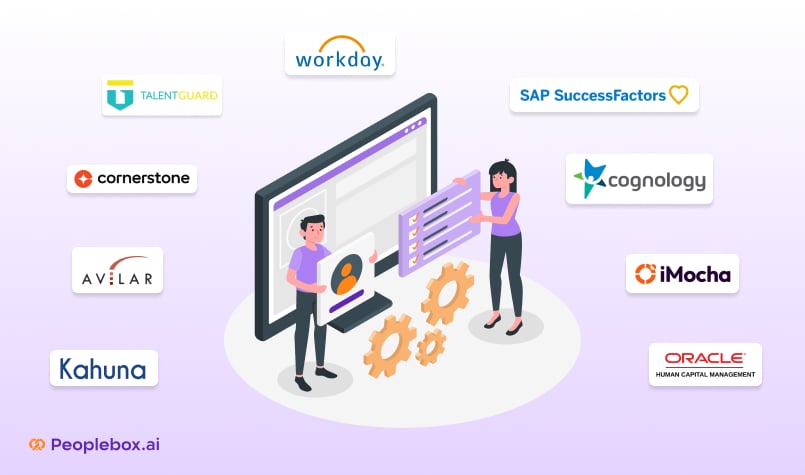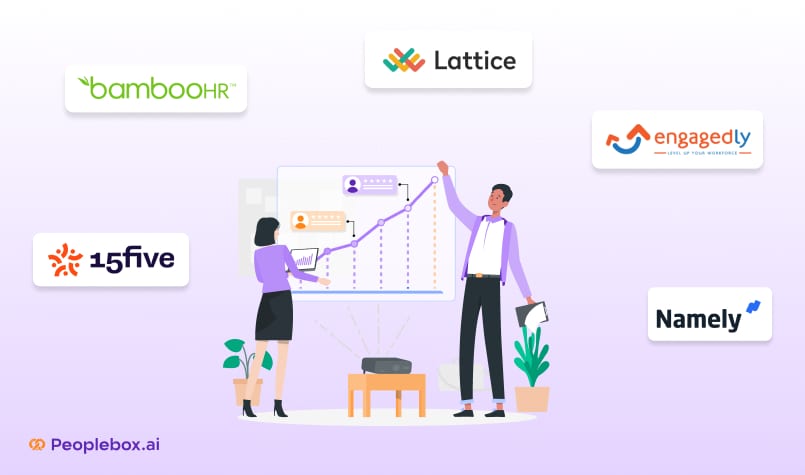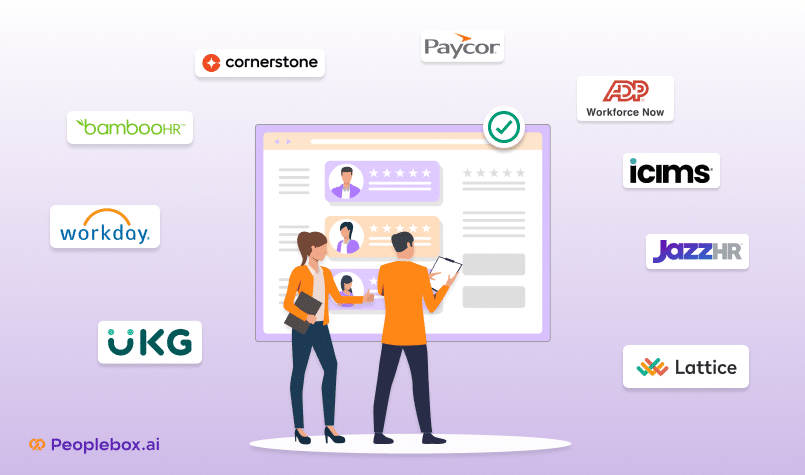People analytics is no longer a nice to have but a must for HR leaders in today’s data-driven business culture. Especially amongst the current economic challenges when companies are increasingly prioritising profitability, HRs are expected to make data-informed decisions to enhance workforce efficiency.
However, the journey from recognising the need for people analytics to successfully implementing a strategy can be challenging.
Hence, we have created this guide to help you:
- Build an effective people analytics strategy
- Identify the right questions to ask of the data for actionable insights
- Get inspired by real-life examples from Google and IBM
Building a People Analytics Strategy: Tips for Smooth Implementation
1. Define your goals and objectives
A people analytics strategy is fundamentally about collecting and applying employee data to drive strategic business decisions.
So, start with a clear vision:
- Define what success looks like for your people analytics initiative.
- Set clear goals – the people analytics initiative should solve business problems.
- Identify key HR questions and challenges that analytics can address.
The key is to establish clear connections between HR metrics and broader business metrics. For example, if the business objective is to increase sales revenue, HR might analyse data to determine how factors such as employee training, sales team composition, or incentive structures impact sales performance.
Here are some examples of goals and objectives that a people analytics strategy might have to support overall business objectives:
| Linking HR Metrics to Business Metrics | |
| HR Metric | Business Impact |
| Improve Talent Acquisition | Enhance workforce productivity by ensuring timely acquisition of top talent, leading to quicker project delivery and improved customer satisfaction. |
| Increase Employee Engagement | Reduce turnover costs and maintain continuity in operations by fostering a positive work environment that promotes employee satisfaction and loyalty. |
| Enhance Performance Management | Improve overall organisational performance by ensuring that employees are focused on high-priority tasks that contribute directly to achieving business goals. |
| Optimise Workforce Planning | Minimise talent shortages and surpluses, ensuring that the organisation has the right people with the right skills in place to support its strategic initiatives. |
| Promote Diversity and Inclusion | Foster innovation and creativity by creating a diverse and inclusive workplace that leverages the unique perspectives and talents of all employees. According to a study, companies with more diversity in their top ranks are 36% more likely to do better financially than other companies in their industry. |
| Maximise Employee Productivity | Increase operational efficiency and profitability by ensuring that employees have the resources and support they need to perform at their best. |
After setting the goals and objectives, you need to identify who will be responsible for executing them.
2. Determine who will be responsible for people analytics
To determine who will be responsible for people analytics in a company, it’s essential to build the right team, establish key roles and skills, and evaluate team structure and ownership options.
Key roles and skills
Implement a multidisciplinary approach by establishing a team including the following experts:
- Data Scientists and Analysts: Proficient in statistics and data analysis.
- HR Professionals: Translate business needs into analytical questions and bridge the gap between HR and data science.
- Data Engineers: Manage data pipelines and ensure data quality.
- “Translators”: Bridge the gap between technical experts and business leaders.
- Business Analysts: Interpret data insights for actionable business decisions.
- Project Managers: Oversee analytics projects to meet organisational objectives.
- Ethics and Privacy Experts: Ensure ethical handling of employee data.
Ownership
Consider appointing a People Analytics Lead with a background in both HR and analytics. For example,
- HR professional with strong analytical skills, or
- Data analyst with HR background.
Team Structure
People analytics teams commonly sit within HR, reporting to the CHRO, but can also be part of a larger analytics group or a combination of HR and business operations. Co-ownership between HR and the business can align efforts more closely with business outcomes.
Team Size
There’s no one-size-fits-all approach; people analytics team size depends on factors like company size, industry, and organizational goals. Insight222’s study showed that the ratio of people analytics team size to total employee headcount stood at 1:2800 in 2023.
After assembling your people analytics team, determine the tools you will use.
3. Choose the right tools and technologies
Research and evaluate different people analytics tools and technologies available in the market. Consider factors such as:
- Integration: Ensure that the chosen tools can seamlessly integrate with your existing systems and data sources.
- Scalability: Choose tools that are scalable and flexible enough to accommodate the changing needs of your organisation as it grows.
- User Adoption: Consider the ease of use for end-users within your organisation. Check if they provide adequate training and support.
- Data Privacy and Security: Ensure that the tools and technologies you choose comply with data privacy regulations (such as GDPR or CCPA) and have robust security measures in place to protect sensitive employee data.
- Advanced Data Analysis: Ensure the selected tools offer advanced data analysis functionalities, including predictive modelling, machine learning algorithms, and statistical analysis, to uncover deeper insights from data.
- Dashboards: The tool can create intuitive dashboards and visualisations to effectively communicate insights.
If you are looking for a tool that offers all this and more, check out Peoplebox.
“We switched to Peoplebox because of its intuitiveness and ease of use.” – Aditya Kumar, Lead HR at Khatabook
Modern tools help companies collect a lot of employee data, but it’s important to use it ethically and securely.
4. Prioritise privacy and ethics
Privacy
Organisations must prioritise the privacy of their employees by:
- Transparency: Employees should be informed about what data is being collected, how it will be used, and who will have access to it.
- Anonymisation: Whenever possible, organisations should aggregate and anonymise employee data to protect individual privacy.
- Data Minimisation: Collect only the data that is necessary for achieving specific business objectives. Avoid collecting excessive or irrelevant data.
- Security Measures: Robust security measures should be implemented to safeguard employee data against unauthorised access, breaches, or cyber-attacks. This includes access controls, encryption, and regular security audits.
- Compliance: Organisations must comply with relevant data protection laws and regulations, such as the General Data Protection Regulation (GDPR) in the European Union or the California Consumer Privacy Act (CCPA) in the United States. Develop clear policies on data privacy and ethical use.
In addition to privacy concerns, organisations must also consider the ethical implications of their people analytics initiatives.
Ethics
Ethics involve doing what is morally right. Some key ethical considerations in people analytics include:
- Fairness and Bias: Algorithms used in people analytics can inadvertently perpetuate bias if they are trained on biased data or if the underlying assumptions are flawed. Organisations must work with DEI experts to evaluate and mitigate biases to ensure fair treatment for all employees.
- Informed Consent: Employees should have the opportunity to provide informed consent before their data is collected and used for analytics purposes.
- Accountability: Organisations should ensure compliance with ethical guidelines and standards, which may include internal documents such as Professional Codes of Conduct or Ethical AI Principles.
- Employee Empowerment: Empower employees to access and control their own data. Allow them to review and update their data preferences.
Once you’ve ensured security and privacy, you can proceed to the next step: collecting the data.
5. Collect and analyse your data, focusing on actionable insights
Effective data collection and analysis are a must for informed decision-making.
Collecting data
Key considerations for collecting data include data integration, data quality, accuracy, and consistency.
- Data Integration: Integrate data from diverse sources to create a comprehensive dataset. Use compatible systems and tools for seamless integration.
- Data Quality: Prioritise data quality by verifying its accuracy, relevance, and completeness. Implement validation checks and protocols to maintain high-quality data.
- Accuracy: Ensure data accuracy by cross-referencing information and validating sources. Regularly audit data to identify and correct inaccuracies.
- Consistency: Maintain data consistency by establishing standardised formats and protocols to ensure uniformity across datasets.
Once you have collected the data, it is time to analyse it.
Analysing data
The analysis involves examining data to uncover insights, trends, and patterns to make decisions.
It encompasses techniques such as statistical analysis, data mining, and visualisation to extract valuable information from raw data. Data analysis helps organisations:
- gain actionable insights,
- identify opportunities, and
- address challenges.
To fast-track results, integrate AI-powered analytics tools. With these advanced tools, organisations can automate processes, detect complex patterns, and forecast trends with greater accuracy.
Innovative people analytic tool Peoplebox also provide interactive visualisations and real-time monitoring.
The right tool can streamline and simplify the process, but the true value of the insights emerges from the questions you pose to the data.
Focus on actionable insights
Many organisations are good at collecting data but less adept at translating it into actionable steps. Whether or not you derive actionable insights depends greatly on the questions you ask.
Here’s a table illustrating not actionable or less insightful examples versus good examples of questions or data points that lead to impactful results:
| Not Actionable Examples | Good Examples |
| How many employees do we have? | Which departments have the highest turnover rates, and why? |
| What is the average age of employees? | What specific skills are lacking in teams with lower productivity? |
| How many training sessions were conducted last year? | How does employee engagement correlate with performance metrics? |
| What is the average salary across the company? | What factors contribute to high performers leaving the company? |
| How many employees left the company last month? | What are the characteristics of teams with high employee satisfaction? |
Actionable Insight from Google
“What are the key attributes and behaviours of successful managers?”
Google’s Project Oxygen used people analytics to identify the characteristics of effective managers by analysing data from employee surveys, performance reviews, and other sources.
This led to the development of Google’s “8 Traits of Highly Effective Google Managers”.
This project not only changed Google’s approach to evaluating managers but also contributed to a broader understanding of effective management practices.
Actionable Insight from IBM
“How can we predict which employees are at risk of leaving the company?”
IBM leveraged people analytics to develop predictive models for employee turnover by analysing factors such as job satisfaction, performance ratings, and career advancement opportunities.
These models helped IBM identify at-risk employees and implement targeted retention interventions to reduce turnover rates and save nearly $300 million in retention costs
The discovery of insights is only as valuable as the ability to communicate them effectively to stakeholders.
6. Communicate your results
Effective communication ensures that insights lead to action.
Know your audience
Before diving into the data, it’s critical to understand who your audience is. Tailor your communication to meet the needs of your audience:
- For Executive Leadership: Focus on strategic implications, ROI, and how insights support business objectives.
- For Managers: Highlight actionable insights, team-specific recommendations, and potential impact on performance and engagement.
- For Employees: Emphasise personal growth, opportunities, and how their feedback contributes to organisational improvements.
Craft a Compelling Narrative
Craft a compelling story about your data that resonates with your audience.
A compelling narrative around people analytics should:
- Start with Why: Begin by explaining why the analysis was conducted and its relevance to both the organisation and the individuals it affects.
- Present Key Findings: Use clear, concise language to present the insights. Avoid jargon and overly complex explanations.
- Visualise the Data: Leverage charts, graphs, and infographics to make data more accessible and engaging.
- Highlight Actionable Insights: Move beyond the data to provide recommendations that are specific, measurable, and actionable.
Facilitate an Open Dialogue
Communication should not be a one-way street. Encourage feedback, questions, and discussions around the findings.
An open dialogue:
- Promotes Engagement: Stakeholders are more likely to support and act on analytics insights if they feel their perspectives are considered.
- Uncovers Additional Insights: Feedback can provide new angles and considerations that might have been overlooked.
- Builds Analytics Culture: Regular, open communication about analytics findings fosters a culture that values data-driven decision-making.
If you have communicated clearly to the right stakeholders, it would naturally lead to putting insights into action.
Putting Insights into Action
Here’s the culmination of your efforts: translating data into action for tangible business results.
- Prioritise Actions: Prioritise actions based on the insights gathered. Which changes will have the most significant impact?
- Develop Action Plans: Create detailed action plans that outline steps, responsible parties, timelines, and resources needed.
- Communicate Changes: Stress the importance of communicating any planned changes to the wider organisation, explaining the reasons behind the changes and how they will benefit employees and the organisation as a whole.
- Implement Changes: Implement the changes smoothly and effectively, including any necessary training for employees or managers.
- Measure Impact: Measure the impact of the changes made, to ensure they are having the desired effect and to inform future actions.
This leads us to the final step in a cyclical process: monitoring and refining the strategy.
8. Regularly monitor and refine the strategy
It’s important to recognise that what works today may not work tomorrow. Regularly evaluate your analytics strategy against your set objectives and metrics.
Use these insights to refine your strategy, processes, and tools over time – in response to new insights, changes in organisational goals, or shifts in the industry landscape.
Remember, building a successful people analytics strategy is an ongoing process. Or, as Kathleen Hogan, Chief People Officer at Microsoft says, “We have ways to go, and we have to earn our aspired culture every day… You can’t freeze culture in a declaration.”
Conclusion
The ultimate goal of people analytics is to identify, align and retain top performers to drive business success.
To gain actionable business insights from your people data, try Peoplebox today.







